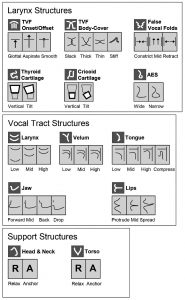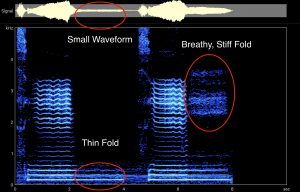Brian J. Winnie, D.M.A.,
Director of Choral Activities at Western Illinois University
Score analysis is an integral process that helps conductor-teachers thoroughly examine repertoire and composer intention. This process typically includes completing a harmonic analysis, highlighting various musical elements such as expressive markings, and making note of sections that will be challenging for singers. However, there is one component missing from the score itself: how the composer intended it to sound. Although some composers write descriptors above sections of music such as “hushed,” “angelic,” or “with driving force,” these can have varied interpretations depending on the performer. There are also many ways singers can interpret a piano dynamic. Therefore, it’s beneficial for conductor-teachers to know all the ways a singer can produce an expressive marking, sing a particular pitch, or balance a particular chord. In this regard, sound and vocal skill development are then linked to all components of score analysis. This can be accomplished by integrating knowledge of vocal anatomy, physiology, psychoacoustics, and gesture’s connection to learning into our score analysis process.
Getting Started
There are many workshops and professional development seminars that can help conductor-teachers grow in their knowledge of voice science principles prior to incorporating vocal skill development ideals into score analysis. Some of these include: Acoustic Vocal Pedagogy, Complete Vocal Technique, Estill Voice Training, The New CCM Vocal Pedagogy Institute, Somatic Voicework™, and VoiceScienceWorks. In particular, the Estill Voice Training (EVT) model is based on the physiological, acoustic, and perceptual aspects of voice production. EVT includes 13 anatomical structures, and their conditions, that singers can maneuver to produce changes in vocal quality (see Fig. 1). These changes can be felt kinesthetically, heard aurally, and seen visually via spectrogram software. The 13 structures are explored through Figures for Voice™, which are physical exercises that explore the range of movement for each anatomical structure.[1]

Knowledge of this vocal anatomy and physiology can greatly influence our goal setting and score analysis. For example, on the pitch E4 some tenors might constrict the False Vocal Folds, or some might “flip” into falsetto, or a stiff vocal fold production. When choosing repertoire, it would then be helpful to choose pieces that incorporate this pitch area in order to create exercises that address these tenor concerns and provide more vocal options for singers.
Score Analysis for Vocal Skill Development
This is a five-step process which begins with the foundational elements of score analysis. Although these steps are listed in a particular order, conductor-teachers should feel free to skip ahead or revisit previous steps throughout the analysis process. It is the hope that this in-depth score analysis can eventually be completed with your singers as an assessment and guided learning activity after they are able to identify these elements.
- Research short biographical information of the composer and poet/librettist. Research the composer and poet/librettist to understand their context and intention. Make educated guesses, based on research, about what they might have heard from singers of their time period. Contact them if they are still alive. Research what type of vocal qualities and stylistic choices they may have audiated while composing.
- Complete a musical analysis. The musical analysis serves as our guide to “unlock” the composer’s intention and overall teaching plan. Our goal in musical analysis should be to find as many entry points into the piece as we can, and then use the previous assessment data to find the best possible entry point to help singers transfer previous learning and grow toward new learning. This includes, but is not limited to, an analysis of rhythm, melody, harmony, texture, dynamics, articulation, form, style, and performance practice.
- Textual analysis. This portion of analysis can help conductor-teachers examine textual elements and their interaction with musical and vocal technique elements. For example, a particular vowel or unvoiced consonant may be the cause of inconsistency in vocal quality. If a singer sings the word “thought” and is asked to make the initial “th” louder, they might inadvertently use the same breath energy or airflow rate on the subsequent vowel. This may cause constriction in the vocal tract, over-adduction of the vocal folds, or it may push the vocal folds open creating a breathier quality. Instead, the conductor-teacher may want to consider which type of onset to utilize after the unvoiced consonant. Detailed analysis can help conductor-teachers plan exercises or modifications to help singers maneuver these textual interactions.
The analysis should include IPA transliterations of foreign text, dialect alterations, and uncommon words in a singer’s native language. It should also include syllabic and agogic word stress analysis, personal interpretations, and poetic/literal translations of texts. Syllabic stress can be another difficult concept to teach in a group setting. In order to perform this task, singers must understand how to vocally unstress a particular syllable and must know our desired choice. For example, the conductor-teacher could state, “Singers, decrescendo here by thinning out the vocal folds” rather than saying “Everyone needs to get softer here.” The first statement provides a specific physiological vocal instruction for achieving an expressive result. The second statement leaves it up to the singers to make their own choice. Some singers may get softer by becoming breathy. Others might lower their tongue, soft palate (velum), larynx, etc. These options can easily be seen via spectrogram software. Figure 2 depicts a waveform and spectrogram image of two sung examples of the word “singing” on the pitch Eb3. The first example demonstrates the unstressed syllable /-ing/ performed with a thin True Vocal Fold Body/Cover. This resulted in a softer perceived dynamic as seen in the smaller amplitude waveform and lower frequency harmonic energy, both circled in red. The second example demonstrates the unstressed syllable /-ing/ performed with a breathy, stiff True Vocal Fold Body/Cover, which produced interharmonic breath noise, also circled in red.
It behooves conductor-teachers to know the vocal possibilities of this expressive task as we analyze the score and create exercises for singers to achieve our desired outcomes. It also benefits us to recognize and teach all the other possibilities along the way because they might be useful in other contexts. There is no one “right” way to decrescendo only the one we chose based on informed decisions. Conductor-teachers should plan to incorporate individual singer modeling opportunities in the group rehearsal so that singers can learn from one another. This also provides opportunities to assess individual skill development. - Vocal analysis. This can be the hardest area of score analysis because we have to acknowledge our own singing tendencies and biases. A conductor-teacher’s vocal abilities are continually demonstrated when vocal modeling for singers. Therefore, we are always delivering information to singers both intentionally and unintentionally. Through vocal analysis, choose the vocal quality needed for a particular section of a piece and then determine how to help singers achieve it. Ask yourself guiding questions: Can you model those sounds? Do you know what needs to occur physiologically to produce those sounds? Do you know the “recipe”[2] for the desired vocal quality? For example, perhaps you can model a particular classical sound ideal but are not yet able to model a pop sound, or vice-versa. Knowledge of how to produce those sounds is needed in order to know what scaffolded exercises can help teach singers the sound production. An example recipe for a pop style might be Estill Speech Quality with the main ingredients including a thick True Vocal Fold Body/Cover, mid False Vocal Folds, mid Larynx, and a vertical thyroid cartilage.
When planning the overall vocal quality of a particular piece, variations are necessary between sections of the ensemble due to pitch range and balance. For example, you may need more tenor presence on low pitches in a piece that requires an operatic vocal recipe. They could then sing with more chest voice or thicker vocal folds. However, the sopranos might simultaneously be singing a higher pitch and may need to be softer by using more head voice or thinner folds. Tenors and sopranos can sing with these slight variations and still be in the same overall quality.
Conductor-teachers can begin this vocal analysis by audiating, subvocalizing, and singing each vocal line on a vowel and then neutral syllable to add various voiced and unvoiced consonants. Subvocalizing is a process of moving components of the vocal mechanism without sound production during silent reading, imagining, or singing.[3] If you find something challenging, can you pinpoint the cause? Is it musical, textual, or vocal? Each struggle is an opportunity for learning if we guide singers to solutions. Circle the challenge and create short exercises or “vocal solutions” and mark them in your music. Likewise, circle sections that might provide easy access to a particular learning outcome.
Mark intonation and tuning spots where singers may struggle. Why is the octave out of tune? How can we assist a singer’s perception of tuning and what mechanistic elements may help? For example, an overly low larynx may cause the perception of pitch flattening or the inability to reach higher pitches. Therefore, what seemed like a perceptual issue of pitch flattening was linked to a mechanistic element of laryngeal position. Laryngeal lowering can also cause a boost of lower frequency harmonics versus higher frequency harmonics. This can be seen on a spectrogram using VoceVista or Voiceprint software. The previous harmonic score analysis can help determine tuning ideals and then acoustic principles of harmonics can be integrated to encourage intonation understanding.[4]
Every individual need will be different. However, if we take the time to analyze all vocal possibilities and incorporate individual student demonstrations in the rehearsal process, we can create a common language leading to a more efficient learning experience. Of course, a safe learning environment is paramount for this to be successful. - Gestural analysis. Using the previous steps in analysis, identify gestural choices that can help connect sound to sensation. James Jordan states, “The most meaningful way to adjust conducting technique is by achieving a heightened awareness of sound that enables us to stay connected with sound.”[5] Even further, Geoffrey Boers suggests, “By pairing specific gestures with specific sensations of singing, gestures become a metaphor of the singing mechanism, be it functions of resonance or appoggio.[6] Research also suggests that gesturing, along with speech, can reduce cognitive load of working memory during learning of a new task. [7] As research continues to find connections between gesture and voicing, or singing, it may be beneficial to help singers gain a gestural vocabulary to aid in vocal skill development. This can be accomplished through a more detailed score analysis related to gesture and may be different than thinking of typical conducting gesture.
Gesture can be planned according to: Position, Placement, Direction, Speed, Distance/Size, and Effort. Start by planning the breath gestures that will help achieve the intended sound outcomes. If the desired sound begins with a smooth onset, that takes effort and slower speed for the body to produce. The breath gesture can match the sensation of speed and effort in the arms and hands that is needed to coordinate the onset. The gesture would then be replicated on the smooth onset as well.
Throughout the score conductor-teachers should choose gestural movements, mark gestural shifts (e.g., tempo, subdivision, ritardando, etc.), and then explore options of gestures that correspond to elements in the previous vocal analysis. Ask yourself guiding questions: What did it feel like to sing that higher pitch without vibrato? Where was the work felt in the body? What was the sensation of that work or effort? For example, if there is a difficult leap in the repertoire, try singing it while exploring various gestural placements and positions. A lower circular gesture may enable better intonation when performing the leap.[8] When will you use a mirrored gesture with both hands performing the same action and when will you use hand independence or co-dependence? For example, we typically use the left hand for dynamic changes, but singers might connect with mirrored gestures that change in size and effort for dynamic shifts as well. It can also be advantageous to become aware of Laban Movement Analysis to help label gestures using the four categories of Weight, Time, Space, and Flow.[9]

What’s Next?
After a detailed score analysis is complete, the lesson plans, teaching activities, and entry points will most likely already be created. The various vocal skill objectives and exercises can then be integrated into the choral warm-up. This is a pivotal component of each rehearsal that builds foundational vocal skills and knowledge connected to specific learning objectives and the chosen repertoire. It can also aid in fatigue resistance[10] and lead to decreased perceived vocal efforts.[11]
I have developed these ideals into what I refer to as a choral tech-up, which focuses on targeted vocal exercises connected to specific anatomic movement and coordination needed for phonation, aural awareness, and the development of musicianship skills. The tech-up includes, 1) Listening Awareness, 2) Audiation Development, 3) Physical Warm-Up, 4) Semi-occluded Vocal Tract Exercises (SOVTEs), 5) Target-specific Exercises for Breath/Onset Coordination, 6) Target-specific Exercises for Resonance, 7) Vocal Quality Building, 8) Harmonic Exercises, 9) Sight-Singing with Vocal Quality.[12]
The entire tech-up can relate to one particular vocal skill objective. For example, if the goal is to have singers maintain a consistent vocal quality in head voice or with thinner vocal folds, they can: 1) develop a listening awareness to the desired structural component or vocal quality, 2) engage in audiation and subvocalization of that structure or quality, 3) perform a physical warm-up to get their body ready for singing, 4) perform an SOVTE such as a lip trill or straw phonation with a thin vocal fold body/cover, 5) develop the ability to perform smooth onset on all vowels, 6) perform a smooth onset with a thin vocal fold body/cover over a series of pitches, 7) develop an awareness to the overall vocal quality recipe and subtle changes needed while extending the range, 8) build the harmonic structure of a particular chord in the music with this vocal quality in mind paying attention to acoustic ideals, and 9) sight-sing while maintaining this quality. The tech-up can also be interwoven throughout the rehearsal with other musical or aesthetic objectives.
Practice What We Preach
An integral part to this score analysis is practicing during and after the process. Research suggests that preparing to teach a concept can increase learning efficiency.[13] We of course are always preparing to teach, but this idea should run through all aspects of planning and analysis. Are we truly prepared to teach the vocal challenges our singers may meet in pursuit of our desired goals? No matter how prepared we find ourselves for a given lesson/rehearsal, practice can always help. Choral teaching is a skill. Like any skill, our abilities can degrade over time without practice and conditioning. Leborgne and Rosenberg discuss exercise physiology principles in training “vocal athletes.” They suggest students maintain a regular practice regime of at least three days a week “to achieve vocal growth, muscle memory, and vocal fitness.”[14] It may be beneficial for conductor-teachers to follow the same advice to stay vocally and gesturally “fit.”
When practicing, it can be helpful to slightly modify a task on each repetition to strengthen motor skills for both conductors and singers. This is a process called reconsolidation, in which existing memories are recalled and modified with new knowledge.[15] This can be very useful in determining scaffolded instruction activities and exercises toward skill acquisition. Try altering the task slightly on each repeat or focus on something new while completing the exercise.
Be sure to record yourself to be aware of what singers are going to see and hear. Practice teaching all possible vocal challenges noted within your score analysis and provide sample feedback. Most of us can find it difficult to watch and listen to ourselves. However, we can better attend to potential student barriers in our instruction if we know how we look and sound while teaching.
Concluding Thoughts
Conductor-teachers have a wonderful and sometimes frightening responsibility as the only voice teacher some singers will ever have. Although assuring individual vocal development is a monumental task, the planning process can be a great start. We also have to acknowledge that voice science is not just for applied voice teachers. As conductor-teachers, we can better serve the millions of singers we impact worldwide by understanding and integrating the ever-evolving research in voice science. This integration of voice science principles into score analysis has the potential to help us guide singers to be more versatile in their singing ability and more knowledgeable of their instrument. It can also help create a common language between teachers and singers and allow conductor-teachers to facilitate quick adjustments within the rehearsal process. However, it means we are making an investment in our own lifelong learning to educate ourselves in these areas.
We began this journey of teaching to help others grow, learn, and explore understanding and knowledge. And these ideas can help foster that growth for all individuals within our ensembles, no matter the context. For a more detailed Score Analysis Checklist that is associated with Choral Pedagogical Planning visit: https://www.brianwinnie.com/professional-resources
[1] Kim Steinhauer, Mary McDonald Klimek, and Jo Estill, The Estill Voice Model: Theory and Translation (Pittsburgh, PA: Estill Voice International, 2017), 7-29.
[2] The idea of vocal “recipes” was created by researcher Jo Estill. A recipe combines all 13 anatomical structures in specific chosen positions. For more information see: Kim Steinhauer, Mary McDonald Klimek, and Jo Estill, The Estill Voice Model: Theory and Translation (Pittsburgh, PA: Estill Voice International, 2017).
[3] Bruder, Camila, and Clemens Wöllner. “Subvocalization in Singers: Laryngoscopy and Surface EMG Effects When Imagining and Listening to Song and Text.” Psychology of Music, (November 2019).
[4] For more in depth acoustic ideas visit: https://www.voicescienceworks.org/filtered-listening-and-vocal-regions.html
[5] James Jordan, Inside the Choral Rehearsal (Chicago: GIA Publications, 2017), 310.
[6] Geoffrey Boers, “No Utensils Allowed: Using Your Hands to Discover Appoggio,” in The Voice Teacher’s Cookbook: Creative Recipes for Teachers of Singing, ed. by Brian J. Winnie (Delray Beach, FL: Meredith Music Publications, 2018), 7-10.
[7] Raedy M. Ping and Susan Goldin-Meadow, “Gesturing Saves Cognitive Resources When Talking About
Non-present Objects,” Cognitive Science 34, (2010): 602-619.
[8] Melissa C. Brunkan, “The Effects of Three Singer Gestures on Acoustic and Perceptual Measures of Singing in Solo and Choral Contexts” (PhD diss., University of Kansas, Lawrence, 2012), ProQuest Dissertations & Theses Global.
[9] Lisa A. Billingham, The Complete Conductor’s Guide to Laban Movement Theory (Chicago: GIA Publications, 2009).
[10] Matthew Hoch and March J. Sandage, “Exercise Science Principle and the Vocal Warm-up: Implications for Singing Voice Pedagogy,” Journal of Voice 32, no. 1 (2018): 79-84.
[11] Monica McHenry, Jim Johnson, and Brianne Foshea, “The Effect of Specific Versus Combined Warm-up Strategies on the Voice,” Journal of Voice 23, no. 5 (2009): 572-576.
[12] For more detailed information see Brian J. Winnie, “The Horse Before the Cart: Redefining the Choral Warm-Up,” The Choral Journal 60, no. 9 (April 2020): 28-39.
[13] John F. Nestojko et al., “Expecting to Teach Enhances Learning and Organization of Knowledge in Free Recall of Text Passages,” Memory & Cognition 42, (2014), 1038-1048.
[14] Frauke Haasemann and James M. Jordan, Group Vocal Technique (Chapel Hill, NC: Hinshaw Music, 1991), 155.
[15] Nicholas F. Wymbs, Amy J. Bastian, and Pablo A. Celnik. “Motor Skills are Strengthened through Reconsolidation.” Current Biology 26, no. 3 (2016): 338-343.

Brian J. Winnie, D.M.A., is the Director of Choral Activities at Western Illinois University in Macomb, IL, USA, where he teaches undergraduate and graduate choral conducting and literature courses and conducts the University Singers. He has worked with festival choirs throughout the United States and in Russia and has presented at state and regional NAfME, ACDA, and International Conferences. He has published numerous articles and is the editor and contributing author of The Choral Conductor’s Companion and The Voice Teacher’s Cookbook. Dr. Winnie received his Bachelor of Science in Music Education from the Pennsylvania State University, Master of Music Education from the University of Illinois Urbana-Champaign, and Doctor of Musical Arts in Choral Conducting from the University of Washington. He is also an Estill Mentor & Course Instructor of Estill Voice Training. Contact: bj-winnie@wiu.edu; website: https://www.brianwinnie.com/
Edited by Karin Rockstad, USA

